what countries require english to be taught in schools
Leer en español
The Us TODAY Network is launching a series on the Latino community in the United states of america chosen Hecho en United states of america, or made in America. Roughly fourscore% of all Latinos living in the USA are American citizens, merely media coverage of Hispanics tends to focus on clearing and crime, instead of how Latino families live, piece of work and learn in their hometowns. Hecho en U.s.a. tells the stories of the nation's 59.9 million Latinos – a growing economic and cultural force, many of whom are built-in in the USA.
LOS ANGELES – Preschool teacher Rosa Ramirez has a special way of asking her students to line up for playtime outside.
"Pueden pararse si llevan puesto algo de color amarillo, como una abeja," she tells them.
In English, Ramirez would say, "You tin can stand if you lot are wearing yellow – like a bee." Merely this is the half of the school day in which she teaches exclusively in Spanish.
Her students are not confused by her linguistic communication option. Most of the 4-year-olds wearing even a smidgen of yellowish stand up as instructed.
Bilingual educational activity programs can assist children from all backgrounds become meliorate students
Research shows that dual-language programs where children acquire both Spanish and English are particularly helpful for Latino English-linguistic communication learners. Editors note: Video has been updated to remove a educatee who opted out of appearing in photos and video.
Harrison Hill, The states TODAY
The preschool dual-language program at Gates Street Early Instruction Center in Lincoln Heights, one of Los Angeles' oldest neighborhoods with dense populations of Latino and Asian residents, is part of a growing number of bilingual instruction models taking root in California and across the land. Many of them are designed to serve students from Spanish-speaking families, as well as students from other cultures, under mounting prove that learning two languages can assist people from all backgrounds become stronger students.
Roughly 3.8 million students in U.S. schools are native Spanish-speakers who are not practiced in English. They brand up the bulk of the approximately five million students nationwide identified as English language learners, the fastest-growing demographic in schools – and the lowest-performing, as judged by achievement tests and graduation rates.
Sixty-7 per centum of students with limited English language skills graduated loftier school after four years in 2016, compared with 84% of all students, according to federal data.
Language experts recommend how to improve those outcomes: More high-quality, long-term dual-language programs can close the achievement gap in literacy betwixt English language learners and native English language speakers after five to six years, co-ordinate to research.
If nosotros can make children feel more whole and more prepare and more accepted and welcomed and validate their prior knowledge and prior learning experiences, then we've gone a long way to making them ready to learn over the form of a lifetime."
The programs tin be tough to implement. Hurdles include a fence over the all-time style to teach English learners, public hostility confronting those who speak a native language other than English, shortages of bilingual teachers and even the fact that dual-linguistic communication programs ofttimes grow fastest in areas where upper-income parents ask for them. That'due south good for children who participate, but it worries advocates who want to meet language-minority students take equal access.
Pressure is mounting in states where numbers of Latino English learners have surged. Mississippi, South Carolina, Kentucky, Kansas and Maryland take seen the number of English language learners more than double from 2005 to 2015, co-ordinate to federal data.
"If we can make children experience more than whole and more ready and more accepted and welcomed and validate their prior knowledge and prior learning experiences, and so we've gone a long way to making them ready to learn over the course of a lifetime," says Tara Fortune, immersion plan manager at the University of Minnesota's Heart for Advanced Research on Linguistic communication Acquisition.
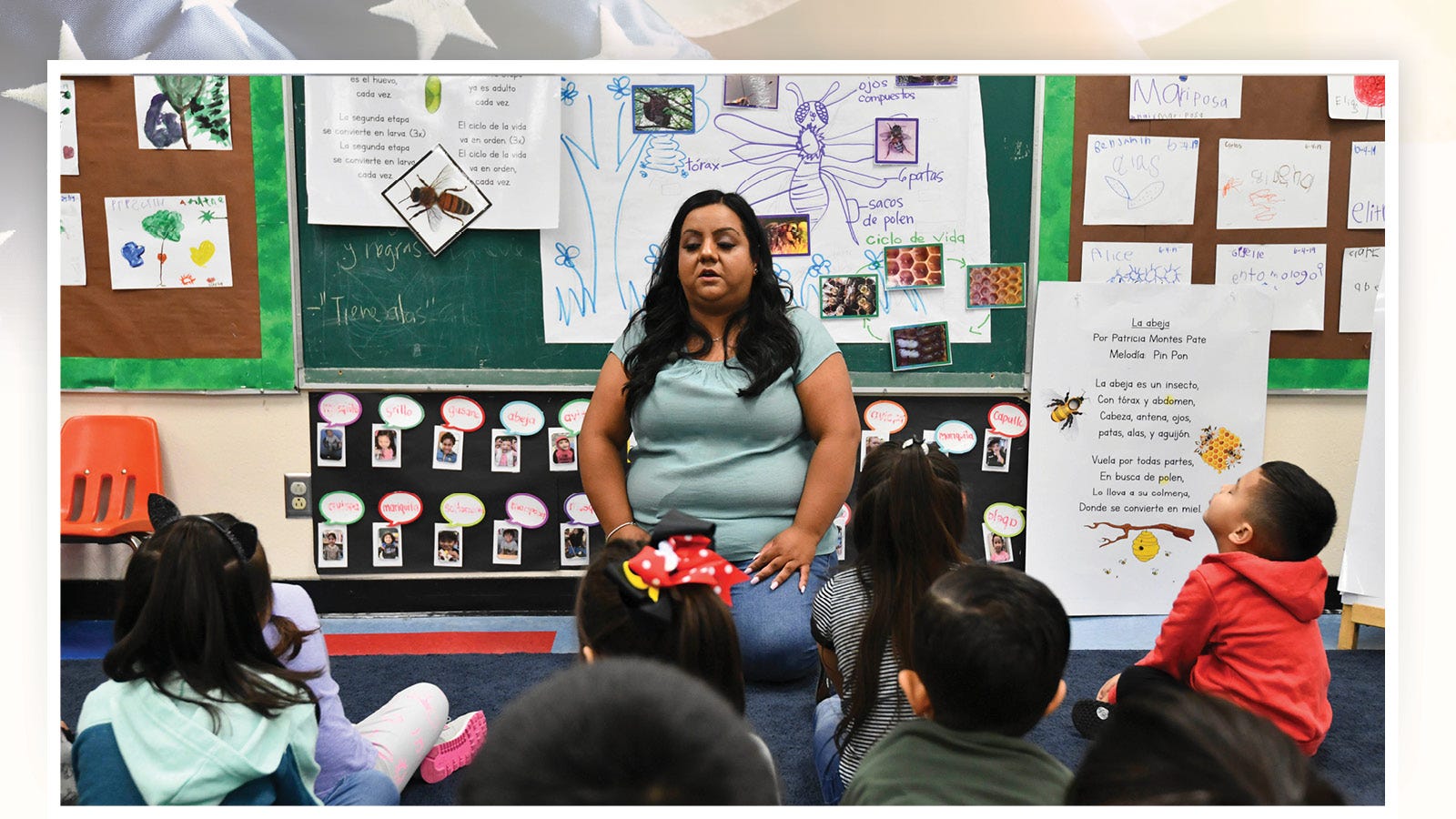
What's the best way to teach language skills to students?
From 2000 to 2015, the percentage of Latino students enrolled in public unproblematic and secondary schools swelled from xvi% to 26%. The percentage of white students fell from 61% to 49%, according to the National Center for Education Statistics.
Federal law requires districts to identify students with express English skills and to serve them with an equitable, research-based program. Practices vary widely between states and districts.
Some schools use transitional bilingual programs, which teach academics such equally science, math and social studies in Castilian for a few years before transitioning students to mainstream classes.
Many utilize English equally a 2nd Linguistic communication pedagogy, a set of methods and techniques originally developed to teach English to foreign diplomats and academy students. Educational activity happens in English language, and teachers have to be certified.
Then there are "English-merely" models, which call for separating language-minority children and having them learn all subjects only in English.
"It's very political because the public doesn't actually understand the process of 2d linguistic communication acquisition," says Maria Coady, an associate professor of bilingual education at the University of Florida, a country where near 300,000 students are learning English.
"Only the research is actually articulate on what works," she says. "Students learning English do good from loftier-quality, long-term bilingual instruction programs."
Nationwide, at that place were almost iii,000 dual-language programs as of 2015, says Santiago Wood, executive director of the National Association for Bilingual Education. That'due south a big increase over nearly 300 operating effectually 2001, he says, only not plenty to help the surging numbers of English learners.
In some districts, the popularity of dual-linguistic communication programs has led to concerns that English learners, who often come from lower-income families, volition be pushed out by native English speakers from more than affluent families.
At Oyster-Adams Bilingual School in Washington, for example, just 24% of students are English learners, co-ordinate to schoolhouse data.
Oyster's program was created to serve the Latino population, just gentrification over the by 40 years collection low-income families from the neighborhood, says Vanessa Bertelli, co-founder of a grassroots organization that advocates for more dual-linguistic communication programs.
"At that place are more than than 10,000 students learning English language in D.C., and even if every one of those students enrolled in a dual-immersion school, at that place wouldn't be plenty seats for them," says Bertelli of the DC Language Immersion Project.
"At that place'due south a lot of energy wasted on trying to allocate the pie, when what we should be doing is making more pies," she says.
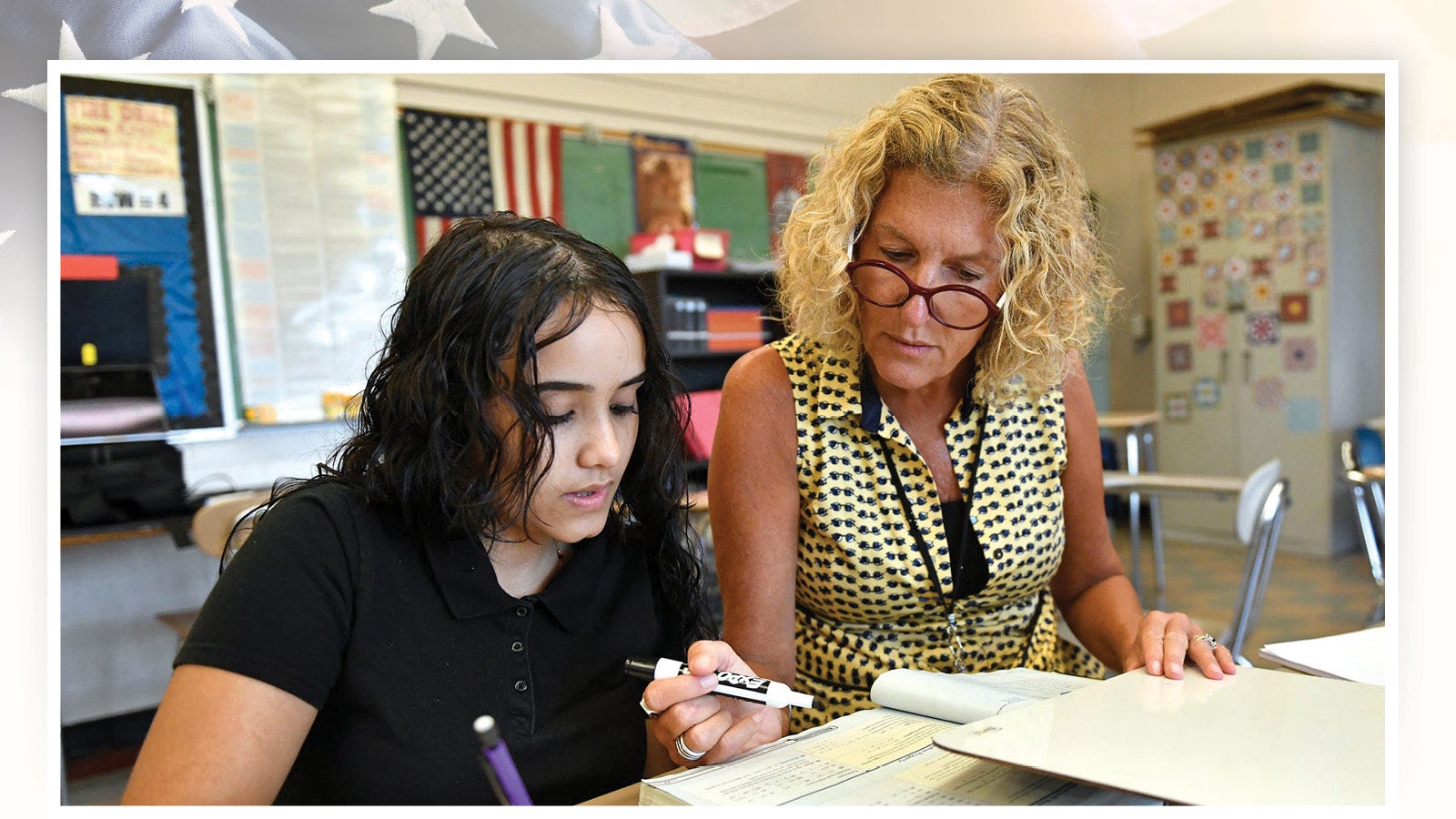
Learning 'English past osmosis' does not work for most students
The USA has a complicated history when information technology comes to Spanish in public schools.
The land does not have an official linguistic communication, just for many decades, some states fabricated English the law of their land by embracing practices that restricted or punished children for speaking a language other than English in schools.
"The idea was fourth dimension on task: put 'em in in that location, and they'll learn English by osmosis," Coady says. "Sometimes that works for very young kids. But for a 10th grader coming into high school only speaking Mandarin who needs to graduate in iii years? There'south no way that child has equitable admission."
In the belatedly 1990s and early 2000s, a focus on English-only instruction became more than pronounced every bit a wave of anti-immigrant sentiment led to ballot initiatives in several states that effectively outlawed teaching in multiple languages.
California voters approved a ban on bilingual pedagogy in public schools in 1998. Known as Proposition 227, the policy barred many children of Latino immigrants and Latino immigrant children from bilingual education, says Ramon Martinez, an assistant professor at Stanford Academy's Graduate School of Education in California.
Led by California businessman Ron Unz and supported by the lobbying group ProEnglish, which favors English-only classes and the adoption of English language every bit the official language of state and national authorities, like restrictive bans passed in Arizona and Massachusetts.
It's very political because the public doesn't really understand the procedure of second language acquisition. Only the research is really clear on what works. Students learning English benefit from high-quality, long-term bilingual didactics programs.
Ramirez, the Gates Early Learning preschool teacher, was a educatee in Due east Los Angeles during the ban in California. She was taught in Castilian and English through second form earlier Proposition 227 went into effect when she was about 8. Later on that, she struggled.
"I remember my third course, I only kind of shut downwards considering I had an idea and comprehended English, just I didn't feel confident to speak information technology," Ramirez says, holding back tears. "Now coming back and working where I grew up, I experience similar many years agone I was where my kids are now. I want to make certain they don't go through the lack of confidence I faced because of the language."
California voters repealed the state'south ban on bilingual instruction in 2016. Massachusetts overturned its English-simply didactics police force in 2017. Arizona officials, many of whom fought fervently for years to keep Spanish education out of public schools, are watering downwards its law, in part considering outcomes for English language learners there have been dismal.
At concluding count by the federal Department of Educational activity, Arizona had the lowest graduation rate for English learners of all states: In 2016, just 32% of them graduated in four years.
"Our English learner population was performing worse on tests than our special teaching population," says Republican state Sen. Paul Boyer, a function-time teacher who supported efforts to change the law to help students learning English language.
At that place are more than 10,000 students learning English language in D.C., and even if every 1 of those students enrolled in a dual-immersion school, there wouldn't be plenty seats for them. In that location'southward a lot of energy wasted on trying to allocate the pie, when what we should be doing is making more than pies."
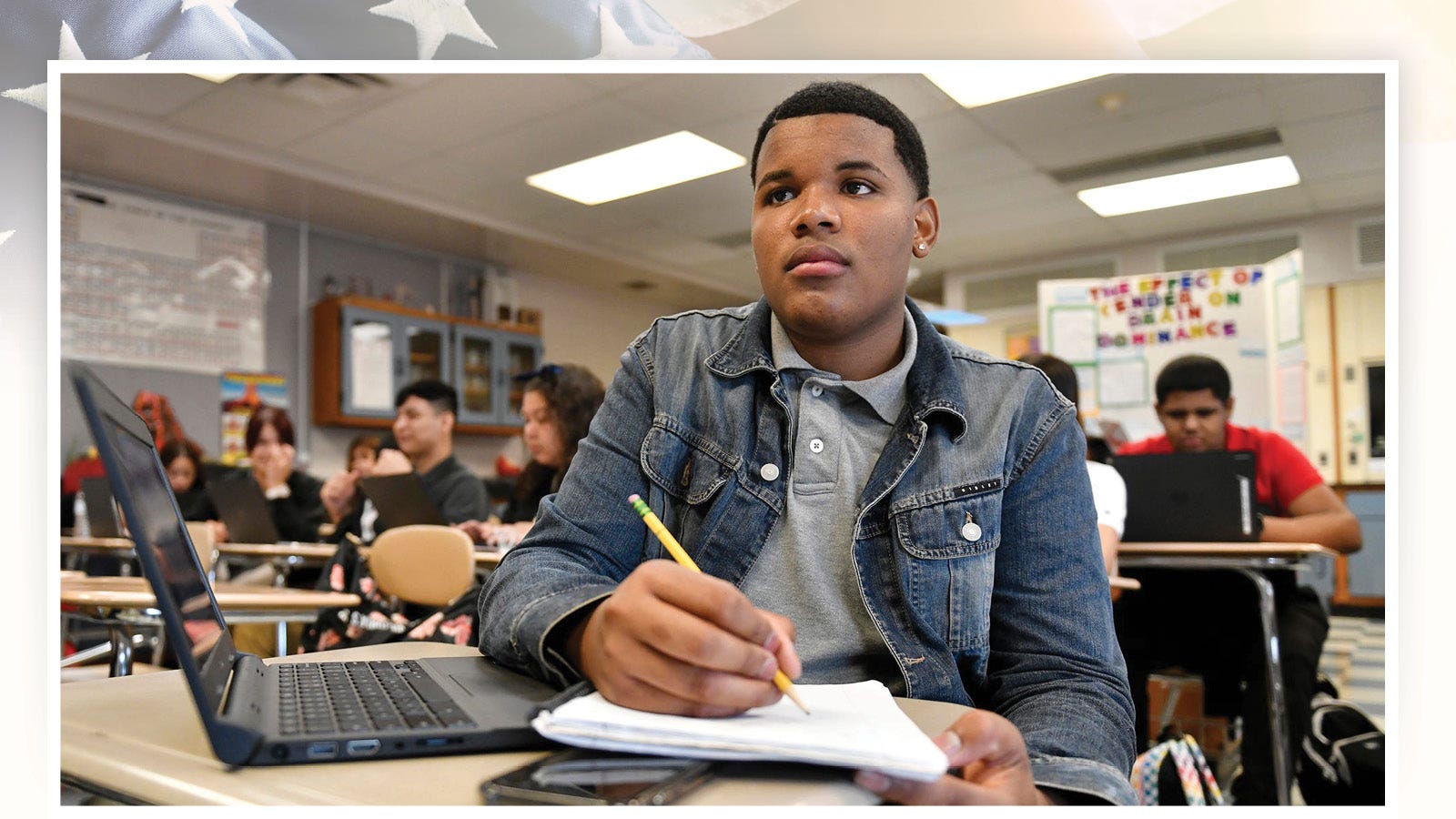
English learners make progress
The city of Vineland, New Jersey, about an hr south of Philadelphia, represents changing U.Due south. demographics. More than lx% of the 11,000 students in Vineland Public Schools are Latino, reflecting a long-continuing Puerto Rican community and a swell of migrants from Central America in recent years. Many of those new arrivals are teens who came without their parents and have no recent history of attention school.
Some of the school's parents piece of work in the surrounding eggplant and cauliflower fields during the solar day. Some are highly transient, migrating with the seasons wherever the piece of work is.
Like many districts in New Jersey, Vineland hosts a transitional bilingual program for students who arrive with limited English skills. This year, about 800 students are enrolled. They larn their cadre academics in Castilian – often correct side by side door to classes where the same content is taught in English – but they accept fourth dimension built into the day for speaking, reading and writing in English.
More: Vineland ESL, bilingual programs win state honors
During the first calendar week of school this fall at Vineland High School, students in a 10th grade bilingual algebra class solved problems written on the board while their teacher wandered around, greeting students and checking their homework.
"Did you end them all, Rafael?" she asked one educatee in English.
She turned and saw that another had neglected to carry a negative number through an equation. She tapped the student'due south reply: "Y united nations negativo, no?" she said.
Our information shows that proficiency in literacy in the child's start language is a very adept indicator of how well that kid is going to eventually acquire English language.
Vineland's bilingual program has been bolstered past JoAnne Negrin, supervisor of bilingual education. Since she was hired seven years agone, she fabricated sure that all new textbook purchases were available in both Spanish and English, so students in the bilingual program could larn at the aforementioned pace as their English-speaking peers.
She made sure bilingual teachers in the lower grades weren't delivering the same lessons in both languages over the class of the day.
"If y'all're repeating lessons every 24-hour interval, yous're never going to help these children brand progress," Negrin says.
Vineland'south English language learners show some of the highest bookish comeback scores in the district, she says. Last year, the students met all the targets outlined on the land written report cards.
"People sometimes question, 'How are students going to larn English if they spend the whole day learning in Spanish?' " Negrin says. "Well, our data shows that proficiency in literacy in the child'due south first linguistic communication is a very good indicator of how well that child is going to eventually larn English."
Other pocket-size victories are happening. Kevin Sanchez, 17, who arrived from the Dominican Republic last year with limited English language, won outset place in a regional science fair later investigating how windmills worked and building a model of ane.
Sanchez near backed out from the fair when he learned that participants were required to brand an oral presentation to the judges. Encouraged by his bilingual science teacher, Sanchez enlisted a friend to translate for him.
People talk about closing the achievement gap, but information technology's more than endmost the opportunity gap. It'south of import that we come up back to the original purpose of dual language, which is to serve the marginalized population."
"It felt really good that a educatee like me could win in a fair like that," Sanchez says in Spanish.
Negrin, who grew upwards every bit a bilingual child abroad, translates for him.
"And so often people look at bilingual programs as remedial programs," she says as Sanchez returns to his English language equally a Second Language class. "But hither you take a kid winning a scientific discipline fair. There'southward nothing remedial about that."
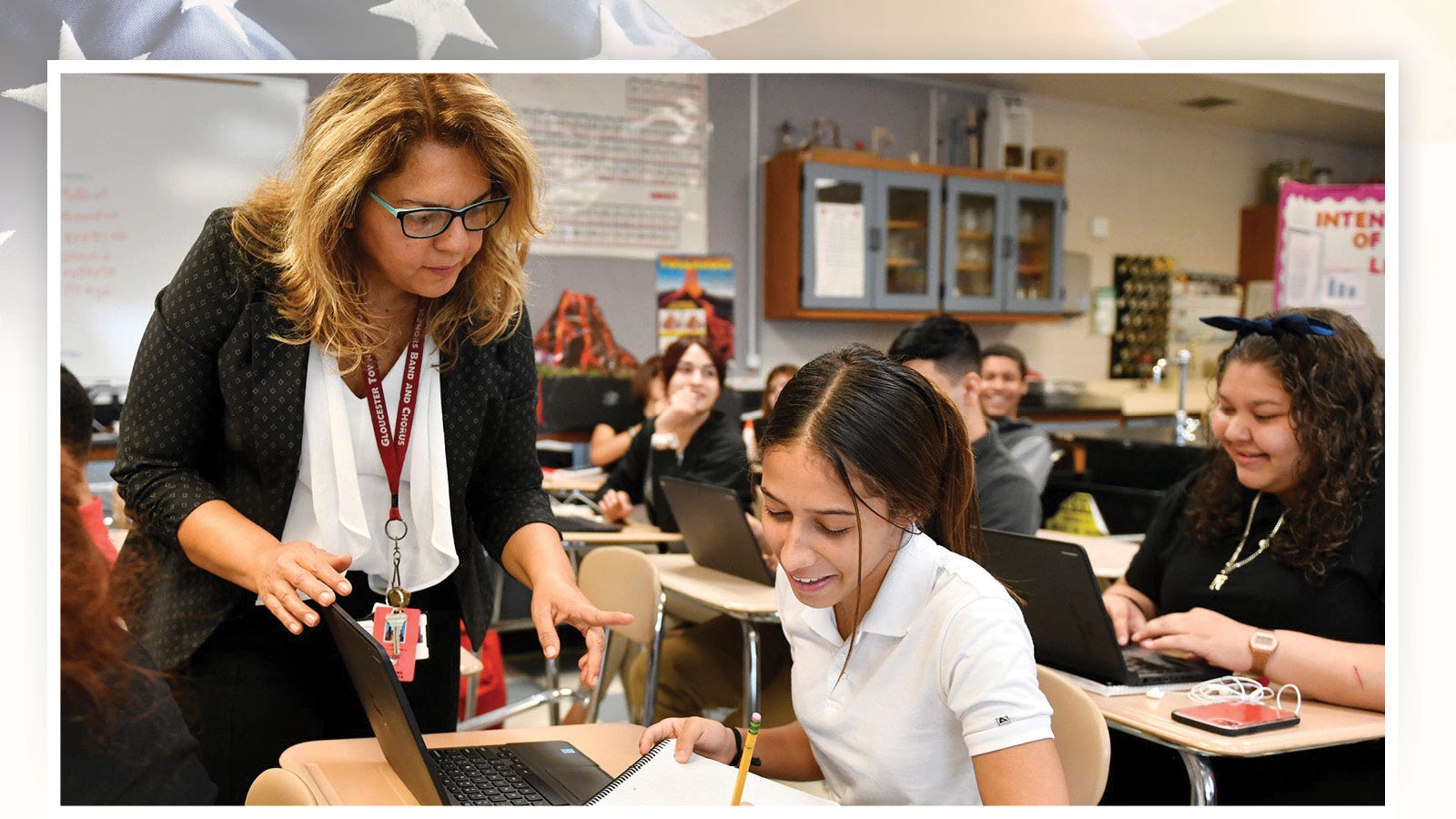
Bilingual teachers in short supply, high demand
Another major barrier to starting or expanding dual-linguistic communication programs is the critical shortage nationwide of teachers who can speak and teach in Spanish and English language.
More than than 30 states reported critical shortages in English as a Second Linguistic communication teachers and world language teachers.
As a result, more districts groom their bilingual teachers, either by helping staff achieve the necessary certifications or by encouraging former bilingual students to come dorsum and teach.
I recollect my tertiary grade, I just kind of close down because I had an idea and comprehended English, only I didn't feel confident to speak it. Now coming back and working where I grew up, I experience similar many years agone I was where my kids are now. I want to make sure they don't go through the lack of confidence I faced because of the language."
In Texas' Rio Grande Valley, close to the U.Due south.-Mexican border, one district and a nearby academy tried to bolster the pipeline of bilingual students condign bilingual educators.
The Pharr-San Juan-Alamo Independent School District serves a about all-Latino population of 32,000 students. The commune has long supported a dual-language, Spanish-English program in all its uncomplicated schools, which has helped close the gap in the early grades for those who are learning English. Students can cull to continue in the bilingual program in high school.
After students graduate, they can continue their bilingual studies in Spanish and English language at the University of Texas-Rio Grande Valley.
The university added a small-scale in bilingual secondary didactics, says Janine Schall, chair of the bilingual and literacy studies department.
"About of our students come up from the local customs and program to return to teach in local Chiliad-12 schools afterward graduation," Schall said.
The academy can't expand fast plenty, she says. Would-exist bilingual teachers often face challenges such as the cost of their education and the tests they take to take to become certified in bilingual pedagogy.
"Nosotros know that there's a greater need for bilingual pedagogy teachers than we tin can run into right now," Schall says.
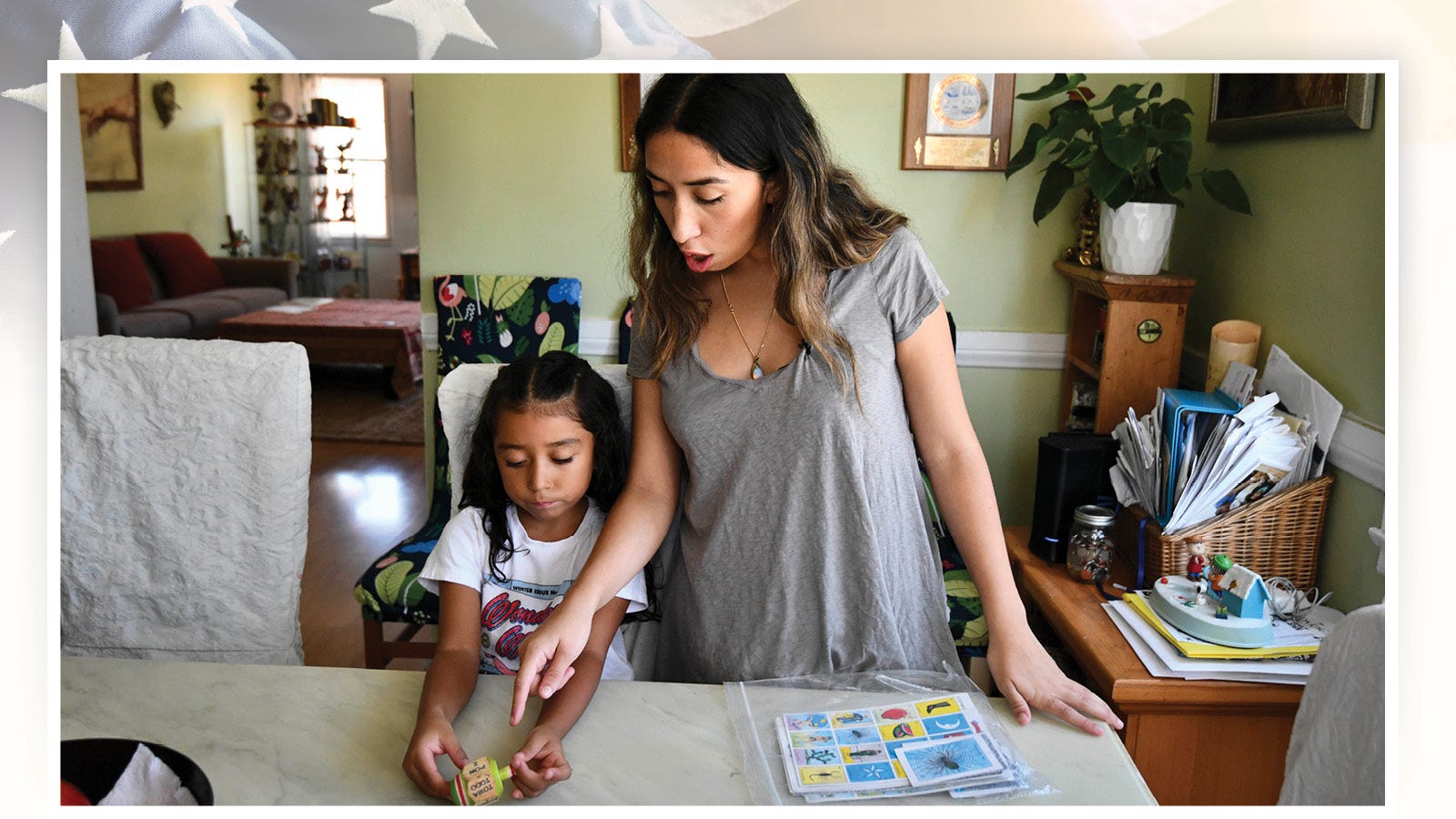
Dual-linguistic communication programs grow in Los Angeles
Virtually 15,000 students were enrolled in the Los Angeles public schools' Spanish/English dual-language programs last twelvemonth. Nearly two-thirds of those students came from Castilian-speaking households, the others were native English speakers, according to district data.
Nearby, the University of California, Los Angeles' Lab School has hosted its dual-linguistic communication immersion programme since 2013. Every bit a private school operated by the university's Graduate School of Education, the Lab School wasn't beholden to California's law that banned bilingual pedagogy in public schools.
Most 40% of students in the plan speak Castilian at habitation.
Elena Perez, a bilingual preschool instructor there, says immersing Spanish-speaking children in their native language empowers them and helps them excel past their regular education peers academically, socially and emotionally.
Her classroom features a gigantic earth map, and strings and pins link students to the countries from which their families immigrated, such as Republic of guatemala, United mexican states and Peru. I morning, the class sang and swayed to the Spanish folk song "De colores."
Outside learning spaces designed to instill cultural pride, Latino students confront a globe full of structural barriers and racial inequalities, language experts say. They want lawmakers to pay attention to the inquiry and make policy changes that better position English learners to succeed.
"People talk about closing the achievement gap, simply it's more closing the opportunity gap," Perez says. "Information technology'southward important that we come back to the original purpose of dual language, which is to serve the marginalized population."
Contributing: USA TODAY intern Jared Weber
Education coverage at USA TODAY is made possible in office by a grant from the Bill & Melinda Gates Foundation. The Gates Foundation does non provide editorial input.
- Latinos are fastest growing population in US military, but higher ranks remain out of achieve
- Coronavirus' online school is hard enough. What if you're still learning to speak English language?
- More than US schools teach in English and Spanish, but not plenty to help Latino kids
- More Latino students than ever are trying to get their caste, but it'southward fraught and costly
- Latinos make upwardly only 1% of all local and federal elected officials, and that's a big problem
- 25 years after her death, singer Selena inspires fans across the US to pursue their dreams
- Latinos are opening more than small businesses than anyone else in the US
- Miami'south Little Havana no longer bulk Cuban
Source: https://www.usatoday.com/in-depth/news/education/2020/01/06/english-language-learners-benefit-from-dual-language-immersion-bilingual-education/4058632002/
Enregistrer un commentaire for "what countries require english to be taught in schools"